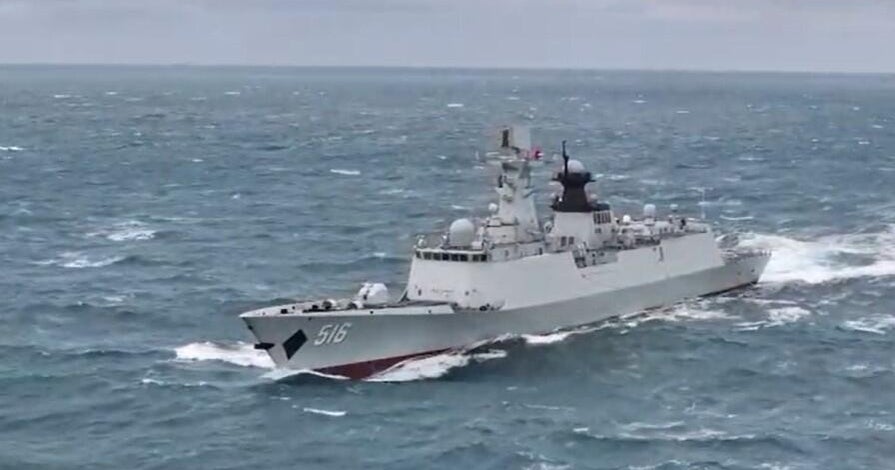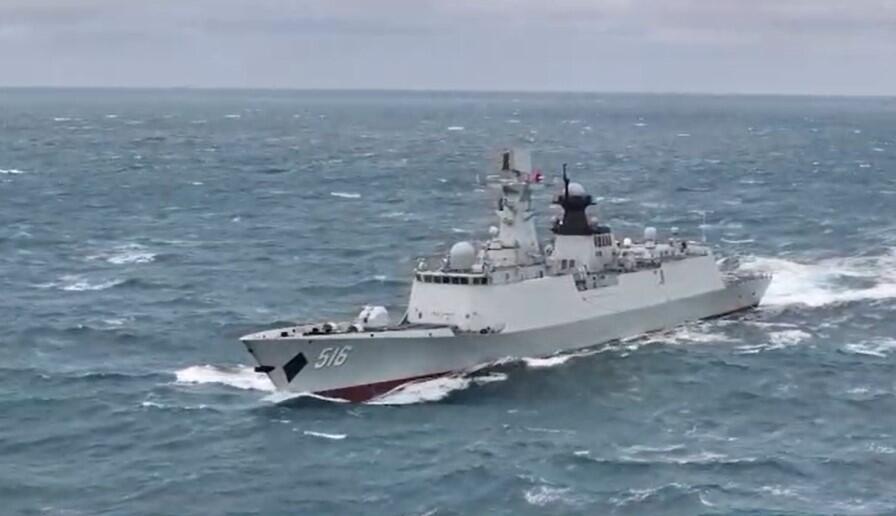China considers Taiwan a part of its territory, to be brought under its control by force if necessary, while most Taiwanese favor their de-facto independence and democratic status. Any conflict could bring in the U.S., which maintains a series of alliances in the region and is bound under U.S. law to treat threats to Taiwan as a matter of “grave concern.”
Taiwan’s Presidential Office said in a message on the social media platform X that “China’s blatant military provocations not only threaten peace in the #Taiwan Strait but also undermine security in the entire region, as evidenced by drills near Australia, New Zealand, Japan, Korea, the Philippines & the SCS. We strongly condemn China’s escalatory behavior.”
The SCS refers to the South China Sea, the strategic waterway that China claims almost in its entirety.
China’s navy also recently held drills near Australia and New Zealand for which it gave no warning, forcing the last-minute rerouting of commercial flights.
U.S. focus on “deterring Communist Chinese military aggression”
China’s latest exercises around Taiwan come days after U.S. Defense Secretary Pete Hegseth visited Japan, where he announced a boost to America’s close military partnership with the Asian nation aimed directly at countering Chinese “aggression” in the region.
Hegseth, in Tokyo on Sunday, called Japan an “indispensable partner” in deterring Chinese assertiveness and announced an upgrade of the U.S. military command in Japan to a new “war-fighting headquarters.” He stressed the need for the U.S. and Japan to do more to strengthen their military capability as the region faces China’s rising assertiveness in its myriad territorial disputes in the region.
“Japan is our indispensable partner in deterring Communist Chinese military aggression,” Hegseth said at the beginning of his talks with Japan’s Defense Minister Gen Nakatani in Tokyo. “The U.S. is moving fast, as you know, to reestablish deterrence in this region and around the world.”
Hegseth’s visit came amid concern in Japan about how U.S. engagement in the region could change under President Trump’s “America First” policy, Japanese defense officials said, speaking on condition of anonymity, citing protocol. Mr. Trump has threatened to impose trade tariffs on Japan, a key U.S. ally, sparking more concern.
The two sides agreed to accelerate plans to jointly develop and produce missiles such as Advanced Medium-Range Air to Air Missiles, or MRAAM, and consider producing SM-6 surface-to-air missiles, to help ease a shortage of munitions, Nakatani said. The ministers also agreed to speed up the process involving the maintenance of U.S. warships and warplanes in Japan to strengthen and complement Japanese and U.S. defense industries.
Stanislav Kogiku/SOPA Images/LightRocket/Getty
There are more than 50,000 U.S. troops based in Japan.
Tokyo last week launched the Japan Joint Operations Command, or JJOC, whose mission is to coordinate Japanese Ground, Maritime and Air Self-Defense Forces, in a significant action to further strengthen capabilities to respond to contingencies and better cooperate with the U.S.
Hegseth announced Sunday the upgrading of its current command, U.S. Forces Japan, by placing a unified operational commander to function as a joint force headquarters to liaise with its Japanese counterpart to serve as “war-fighting headquarters” to bolster speed and capability of their troops’ joint operations.
The Pentagon chief called the reorganization of U.S. troops a step to better prepare for a possible conflict. America and Japan both work for peace, he said, but “we must be prepared.”
China’s latest show of force around Taiwan
Taiwan’s Ministry of National Defense said Tuesday that it had tracked 71 Chinese aircraft and 21 warships in the air and waters surrounding the island during the Chinese exercise. It added that it had been tracking the movement of the Shandong aircraft carrier since Saturday and that its carrier group had entered into Taiwan’s air defense identification zone, a self-defined area tracked by the military.
Reuters/CCTV
China regularly dispatches military assets into the zone, which China does not recognize, but Taiwanese officials have recently warned that China could launch a sneak attack under the guise of military exercises.
“I want to say these actions amply reflect (China’s) destruction of regional peace and stability,” said Taiwan’s Defense Minister Wellington Koo.
Taiwan has set up a central response group to monitor the latest exercises, Koo said.
Daniel Ceng/Anadolu/Getty
The drills come just two weeks after a large-scale exercise in mid-March, when Beijing sent a large number of drones and ships toward the island.
China’s Taiwan Affairs Office said the exercises were directed at Lai Ching-te, Taiwan’s strongly pro-independence president.
“Lai Ching-te stubbornly insists on a ‘Taiwan independence’ stance, brazenly labeling the mainland as a ‘foreign hostile force,’ and has put forward a so-called “17-point strategy … stirring up anti-China sentiments,” said China’s Taiwan Affairs Office in a statement on Tuesday. “We will not tolerate or condone this in any way and must resolutely counter and severely punish these actions.”
In mid-March, Taiwan’s Lai put forward a 17-point strategy aimed at shoring up Taiwan’s national security. The points include allowing espionage cases to be tried by military courts and making immigration rules stricter for Chinese citizens applying for permanent residency.
Lai’s words and actions appear to have especially angered Chinese leader Xi Jinping, whose previous attempts at intimidation have had little effect on the Taiwanese public. Those have often been timed in response to expressions of Taiwanese independence, including a visit by then U.S. House leader Nancy Pelosi.
A new propaganda push by China
China’s PLA also released a series of videos to publicize their military exercise, including one in which they depict Lai as a green parasite “poisoning” the island by hatching smaller parasites. The video shows Lai’s head on the body of a bulbous green worm, with a pair of chopsticks picking him up and roasting him over a flame set over Taiwan.
Beijing sends warplanes and navy vessels toward the island on a daily basis, seeking to wear down Taiwanese defenses and morale, although the vast majority of the island’s 23 million people reject its claim of sovereignty over Taiwan. In recent years, it has stepped up the scope and scale of these exercises, from sending small numbers of individual fighters and surveillance planes to sending groups of planes, drones and ships.
“The PLA organized naval and air forces to practice subjects such as sea and land strikes, focusing on testing the troops’ ability to carry out precision strikes on some key targets of the Taiwan authorities from multiple directions,” said Zhang Chi, a professor at China’s National Defense University in an interview with Chinese state television.
Taiwan and China split amid civil war 76 years ago, but tensions have risen since 2016, when China cut off almost all contacts with Taipei.
Taiwan, War, Xi Jinping, Donald Trump, South China Sea, China, Asia, Japan
#China #holds #major #war #games #Taiwan #U.S #boosts #ties #Japan #deter #Chinese #military #aggression


